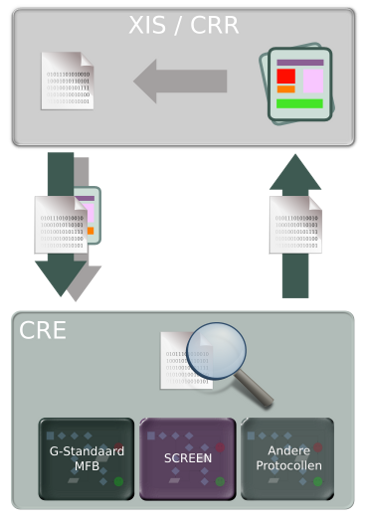The Clinical Information System (CIS) sends the EHR as a structured data set to the Clinical Rules Reporter. The CRR anonymises the data and presents the data to the Clinical Rules Engine (CRE), which will be accessed temporarily for analysis. The CRE then sends a Report back to the CRR, without storing information locally on the CRE. The CR Report is saved in the CRR for a follow-up exchange with the CRE. The CR Report is also accessible through the CIS. Constant communication between the CRR and the CIS provides better support of the longitudinal medication monitoring.
Every healthcare issue is relevant
An important starting point of Clinical Rules is that the health problems detected are monitored in a longitudinal context in contrast to handling isolated incidents. This is all the more relevant, as an increasing amount of patient information is communicated and exchanged electronically and available at different points in time, often between patient consultations. In the light of medication safety, (pharmaceutical) care professionals need to anticipate potential problems that are difficult to identify when prescribing and dispensing medication.
Levels of alertness and prioritisation
The Clinical Rules Reporter (CRR) reports current risk factors based on the patient's risk profile, as well as risk factors that have already been dealt with. It also distinguishes new risks from those previously reported. Such targeted Reports are possible, because the CRR retains previous Reports and sends these to the Clinical Rules Engine (CRE) at each follow-up contact triggered by the Clinical Information System (CIS). The Clinical Rules Engine takes these previous reports into account during analysis and generates a new Clinical Rules Report.
This allows the CRE to determine alert levels. A high alert level (red) would be assigned to a notification, for example, if an important lab result is missing in the EHR. In the second Report the alert level would be reduced to orange, if the same lab result is still missing in the EHR during the second analysis. It is possible that a lab result has been requested and the result is still underway. When the lab result is available and considered ‘normal’, the notification will turn green; in case of an ‘abnormal’ lab result the follow-up notification will turn red again.
If Clinical Rules identifies a high-risk patient and determines that the problem is under control, no priority level will be assigned to the notification (Alert level green).
In this way, health care professionals can easily see which notifications have a higher priority and which are work in progress. Clinical Rules allows them to focus on targeted areas of the patient health record.

